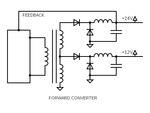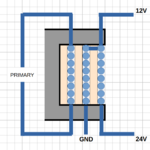kathmandu
Full Member level 5

Hello,
I have designed a 2-switch forward converter (48VDC => 12/24VDC, 100W). As I was needing two outputs (12V/24V), I have decided to buid a center tapped transformer(for a better cross regulation) like in the diagram bellow.
Everything works fine, except I've got around 21V(??) on the tapped output. The secondary winding it's made up of two identical layers (the second one (24V) being on top of the first one).
So why do I get almost the same output voltage on the center tapped output? The 24V output goes to the feedback input of the forward controller (UC3845) and it's very stable.
Thanks in advance for any help.

- - - Updated - - -
This is how the winding layers look like:

I have designed a 2-switch forward converter (48VDC => 12/24VDC, 100W). As I was needing two outputs (12V/24V), I have decided to buid a center tapped transformer(for a better cross regulation) like in the diagram bellow.
Everything works fine, except I've got around 21V(??) on the tapped output. The secondary winding it's made up of two identical layers (the second one (24V) being on top of the first one).
So why do I get almost the same output voltage on the center tapped output? The 24V output goes to the feedback input of the forward controller (UC3845) and it's very stable.
Thanks in advance for any help.

- - - Updated - - -
This is how the winding layers look like:

Last edited:








